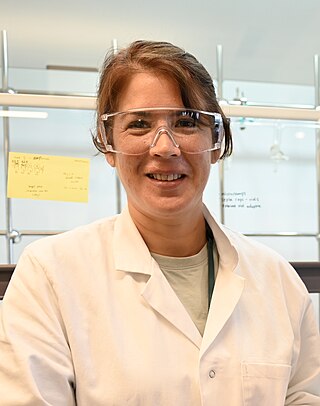Related Research Articles

Organic chemistry is a subdiscipline within chemistry involving the scientific study of the structure, properties, and reactions of organic compounds and organic materials, i.e., matter in its various forms that contain carbon atoms. Study of structure determines their structural formula. Study of properties includes physical and chemical properties, and evaluation of chemical reactivity to understand their behavior. The study of organic reactions includes the chemical synthesis of natural products, drugs, and polymers, and study of individual organic molecules in the laboratory and via theoretical study.

In theoretical chemistry, a conjugated system is a system of connected p-orbitals with delocalized electrons in a molecule, which in general lowers the overall energy of the molecule and increases stability. It is conventionally represented as having alternating single and multiple bonds. Lone pairs, radicals or carbenium ions may be part of the system, which may be cyclic, acyclic, linear or mixed. The term "conjugated" was coined in 1899 by the German chemist Johannes Thiele.

Conductive polymers or, more precisely, intrinsically conducting polymers (ICPs) are organic polymers that conduct electricity. Such compounds may have metallic conductivity or can be semiconductors. The main advantage of conductive polymers is that they are easy to process, mainly by dispersion. Conductive polymers are generally not thermoplastics, i.e., they are not thermoformable. But, like insulating polymers, they are organic materials. They can offer high electrical conductivity but do not show similar mechanical properties to other commercially available polymers. The electrical properties can be fine-tuned using the methods of organic synthesis and by advanced dispersion techniques.
Halocarbon compounds are chemical compounds in which one or more carbon atoms are linked by covalent bonds with one or more halogen atoms resulting in the formation of organofluorine compounds, organochlorine compounds, organobromine compounds, and organoiodine compounds. Chlorine halocarbons are the most common and are called organochlorides.

Pentacene is a polycyclic aromatic hydrocarbon consisting of five linearly-fused benzene rings. This highly conjugated compound is an organic semiconductor. The compound generates excitons upon absorption of ultra-violet (UV) or visible light; this makes it very sensitive to oxidation. For this reason, this compound, which is a purple powder, slowly degrades upon exposure to air and light.

Donna J. Nelson is an American chemist and professor of chemistry at the University of Oklahoma. Nelson specializes in organic chemistry, which she both researches and teaches. Nelson served as a science advisor to the AMC television show Breaking Bad. She was the 2016 President of the American Chemical Society (ACS) with her presidential activities focusing on and guided by communities in chemistry. Nelson's research focused on five primary topics, generally categorized in two areas, Scientific Research and America's Scientific Readiness. Within Scientific Research, Nelson's topics have been on mechanistic patterns in alkene addition reactions and on Single-Walled Carbon Nanotube (SWCNT) functionalization and analysis, yielding the first COSY NMR spectrum of covalently functionalized SWCNTs in solution. Under America's Scientific Readiness, she focuses on science education and impacting science by considering its communities; this includes classroom innovations and correcting organic chemistry textbook inaccuracies, on ethnic and gender diversity among highly ranked science departments of research universities, and on improving the image and presentation of science and scientists to the public.
In chemistry, a halogen bond (XB) occurs when there is evidence of a net attractive interaction between an electrophilic region associated with a halogen atom in a molecular entity and a nucleophilic region in another, or the same, molecular entity. Like a hydrogen bond, the result is not a formal chemical bond, but rather a strong electrostatic attraction. Mathematically, the interaction can be decomposed in two terms: one describing an electrostatic, orbital-mixing charge-transfer and another describing electron-cloud dispersion. Halogen bonds find application in supramolecular chemistry; drug design and biochemistry; crystal engineering and liquid crystals; and organic catalysis.
Angela K. Wilson is an American scientist and former (2022) President of the American Chemical Society. She currently serves as the John A. Hannah Distinguished Professor of Chemistry, associate dean for strategic initiatives in the College of Natural Sciences, and director of the MSU Center for Quantum Computing, Science, and Engineering (MSU-Q) at Michigan State University.

Zhenan Bao is a chemical engineer. She serves as K. K. Lee Professor of Chemical Engineering at Stanford University, with courtesy appointments in Chemistry and Material Science and Engineering. She served as the Department Chair of Chemical Engineering from 2018 to 2022. Bao is known for her work on organic field-effect transistors and organic semiconductors, for applications including flexible electronics and electronic skin.

PIDA, or poly(diiododiacetylene), is an organic polymer that has a polydiacetylene backbone. It is one of the simplest polydiacetylenes that has been synthesized, having only iodine atoms as side chains. It is created by 1,4 topochemical polymerization of diiodobutadiyne. It has many implications in the field of polymer chemistry as it can be viewed as a precursor to other polydiacetylenes by replacing iodine atoms with other side chains using organic synthesis, or as an iodinated form of the carbon allotrope carbyne.

Diiodobutadiyne (1,4-diiodobuta-1,3-diyne) is a small molecule related to diacetylene. It is used in the creation of the polymer poly(diiododiacetylene) (PIDA) by undergoing 1,4 polymerization.

Malika Jeffries-EL is an American chemist and professor of chemistry at Boston University studying organic semiconductors. Specifically, her research focuses on developing organic semiconductors that take advantage of the processing power of polymers and the electronic properties of semiconductors to create innovative electronic devices. She was elected as a Fellow of the American Chemical Society in 2018.
Eilaf Egap is an adjunct assistant professor of Materials Science at Rice University. She works on imaging techniques and biomaterials for early diagnostics and drug delivery. She was a Massachusetts Institute of Technology MLK Visiting Scholar in 2011.
Kenichiro Itami is a Japanese chemist. He is a professor at Nagoya University in the Department of Chemistry, Graduate School of Science, director of Institute of Transformative Bio-Molecules (WPI-ITbM), Nagoya University and the Research Director of the Itami Molecular Nanocarbon Project (JST-ERATO). He received his Ph.D in Engineering from the Department of Synthetic Chemistry and Biological Chemistry from Kyoto University. Itami was held responsible, and the Japan Science and Technology Agency (JST) and the Japan Society for the Promotion of Science (JSPS), which determine the allocation of government research funds, have stopped granting research funds as a penalty until the end of March 2025 from the university. Despite this, RIKEN, which is funded mainly by research fees from the government, hired Itami and obtained about 50 million yen in research funding. He pioneered a loophole that allowed him to obtain research funding by belonging to a national research corporation even if his research funding from the government was suspended due to research misconduct.
Julia Ann Kalow is an assistant professor of chemistry at Northwestern University. She is primarily a synthetic chemist, who works on polymers, photochemistry and tissue engineering. She is interested in synthetic strategies that can turn molecular structure and chemical reactivity into macroscopic properties. She has been awarded the National Science Foundation CAREER Award, Thieme Award and was selected by the University of Chicago as a Rising Star in Chemistry.
Jodie L. Lutkenhaus is a Professor of Chemical Engineering at Texas A&M University who develops redox active polymers for energy storage and smart coatings. In 2019 Lutkenhaus and Karen L. Wooley demonstrated the world's first biodegradable peptide battery. Lutkenhaus is a World Economic Forum Young Scientist.
Emily A. Weiss is the Mark and Nancy Ratner Professor of Chemistry and director of the Photo-Sciences Research Center at Northwestern University. Her research considers the optical and electronic properties of nanostructures, including hybrid organic–inorganic quantum dots. She was a two-time finalist in the Blavatnik Awards for Young Scientists.
Davita L. Watkins is an associate professor of chemistry at the University of Mississippi, where her research interest is in developing supramolecular synthesis methods to make new organic semiconducting materials for applications in optoelectronic devices, as well as studying their structural, optical, and electronic properties. Her group also investigates the design of dendrimer molecules for biomedical applications.
Christopher William Bielawski is a distinguished professor at Ulsan National Institute of Science and Technology and group leader of the Synthesis Group in the Center for Multidimensional Carbon Materials. His research in synthesis and polymer chemistry has resulted in more than 290 publications and multiple patents.

Christine Luscombe is a Japanese-British chemist who is a professor at the Okinawa Institute of Science and Technology. Her research investigates polymer chemistry, organic electronics, organic photovoltaics and the synthesis of novel materials for processable electronics. She serves on the editorial boards of Macromolecules, Advanced Functional Materials, the Annual Review of Materials Research and ACS Applied Materials & Interfaces.
References
- ↑ Nancy Goroff publications from Europe PubMed Central
- 1 2 "Confirmed Invited Speakers › Women for Women" . Retrieved 2020-10-02.
- 1 2 "Professor Nancy Goroff, former member of the Jackson Group, is Congress' first female scientist with a PhD". chemistry.msu.edu. Retrieved 2020-10-02.
- ↑ "Nancy S. Goroff receives award". chemistry.msu.edu. Retrieved 2020-10-02.
- 1 2 3 "Nancy Goroff | Chemistry". Stony Brook University . Retrieved 2020-10-02.
- 1 2 "Dr. Nancy Goroff Appointed Associate Provost for the Integration of Research, Education, and Professional Development and Associate Dean of the Graduate School". SBU News. 2013-09-13. Retrieved 2020-10-02.
- 1 2 "Nancy Goroff". Un ion of Concerned Scientists. Archived from the original on September 1, 2020. Retrieved October 10, 2020.
- ↑ "GOP Rep. Lee Zeldin defeats Democrat Nancy Goroff". WNYW. December 4, 2020. Retrieved March 28, 2022.
- ↑ "NSF Award Search: Award#9984937 - CAREER: Small Neutral All-Carbon Molecules from Well-Defined Precursors". NSF. Retrieved 2020-10-02.
- ↑ "Previous Winners - Thieme Chemistry - Georg Thieme Verlag". Thieme. Retrieved 2020-10-02.
- ↑ "Two Stony Brook University Professors to Receive Prestigious American Chemical Society Awards". newswise.com. Retrieved 2020-10-02.